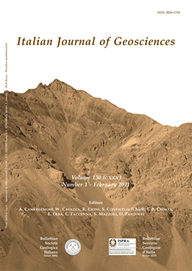
Tectono-stratigraphic evolution of a basin generated by transpression: the case of the Early Pliocene Lascari Basin (northern Sicily)
Giuseppe Avellone(*), Carmelo Gennaro(*), Carlo Gugliotta(*), Massimiliano R. Barchi(**) & Mauro Agate(*)
(*) Dipartimento di Geologia e Geodesia, Università di Palermo, via Archirafi, 20 - 90123 Palermo, Italy. Corresponding author: Giuseppe Avellone, giuavellone@unipa.it
(**) Dipartimento di Scienze della Terra, Università di Perugia, Piazza Università, 1 - 06100 Perugia, Italy.
Volume: 130 (2011) f.1
Pages: 93-105
Abstract
In the present paper integrated stratigraphy and structural analyses are aimed at the description of a synsedimentary transpressional tectonic event, driving the onset and development of the Early Pliocene Lascari Basin, located NW of the Madonie Mountains (northern Sicily).
Our data show that the transpressive tectonics generated a morphostructural high flanked by a deep and narrow tectonic depression, bounded by steep and tectonically controlled slopes. Within this depression an Early Pliocene fining and deepening upward sedimentary succession was deposited, unconformably overlying the already deformed substrate. The succession is made up of «base-ofslope» breccias, cross-stratified calcarenites, and bathyal limestones deposited in a high-energy palaeostrait setting. The growth geometry that characterizes the stratal pattern of the deposits suggests the activity of a synsedrimentary transpressional event during the Early Pliocene time.
The roughly E-W trending Lascari Syncline, where the Early Pliocene syntectonic basin is hosted, belongs to a system of north verging folds, deforming the pre-existing, originally flat thrusts, generated in Langhian-Serravallian time.
This paper presents an original interpretation of the stratigraphic and structural evolution of the study sector of the Sicily Fold and Thrust Belt. Our data contribute also to both define the structural style and constrain the timing of transpressional tectonic event in northern Sicily. A brief comparison performed between the data here presented and those coming from adjacent sectors of northern Sicily suggests that the transpressional tectonics in these sectors of the chain was active at least since the latest Tortonian till at least the Late Pliocene.
Keywords
Get Full Text